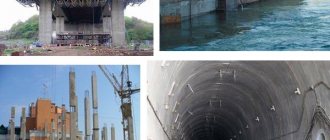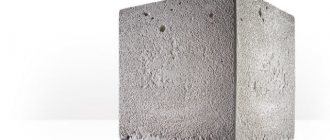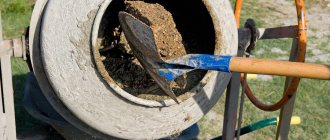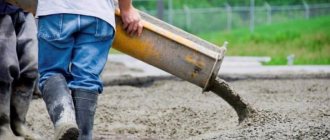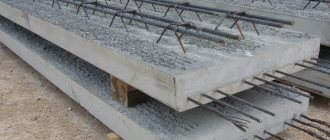Currently, concrete is one of the basic building materials, which includes the following components:
- water, cement, coarse aggregate - expanded clay, crushed stone, fine aggregate - sand.
Ready-mix concrete is classified according to several parameters. The priorities include: type of aggregate and average density. Concrete density classes:
Heavy concrete. It is the main material in the production of reinforced concrete structures, its density ranges from 2200 to 2500 kg/m3, dense aggregates are used for its production. Light or lightweight concrete.
It has a density from 500 to 2200 k/m3 (porous aggregates are used - pumice, expanded clay, etc.). Lightweight concrete is characterized by reduced thermal conductivity and low load-bearing capacity, as a result of which it is used in the production of wall materials intended for “warm” premises.
Compressive strength of concrete – B
The compressive strength of concrete is one of the basic parameters of concrete. Until 1986, the term “Grade of Concrete” was used when designing concrete structures. The grade is designated by the letter “M” with a number that reflects the average compressive strength of the concrete sample in kgf/cm2.
Grades of ready-mixed concrete used in construction: M50, M75, M100, M150, M200, M250, M350, M400, M450, M550, M600, M6OO, M700, M800.
Now, after the adoption of SNiP 20301-84, when performing calculations of concrete and reinforced concrete structures, it is not the concrete grade that is used, but the compressive or tensile strength class. This indicator is displayed by the letter B with a digital combination, which indicates the guaranteed strength in MPa, that is, the strength achieved in most tests (in 95% of cases).
Concrete classes used in construction: B1; B1.5; AT 2; B2.5; B3.5; AT 5; B7.5; AT 10 O'CLOCK; B12.5; B15; IN 20; B25; B30; B40; B45; B50; B55; B60.
Composition and proportions
Concrete class B12.5 does not have a complex composition:
- binder – cement grades M400 and M500;
- coarse aggregate - crushed stone. They mainly use limestone and gravel; it is irrational to purchase a more expensive option - granite due to the peculiarities of using this concrete;
- fine aggregate - sea or river sand;
- water without the presence of foreign particles.
Depending on the selected brand of cement, the ratio of dry components in the solution also varies.
| Cement brand | Cement | Sand | Crushed stone |
| M400 | 1 | 4,1 | 3,8 |
| M500 | 1 | 4,3 | 3,9 |
The amount of water is taken into account directly during mixing, depending on the fraction of fine and coarse aggregates.
Concrete grade for water resistance – W
Water resistance is the property of concrete to resist the effects of water without any destruction, i.e.
e. a moisture-resistant concrete slab will not allow water supplied under pressure to pass through. The mark displays the water pressure - kgf/cm2, at which a concrete sample (cylinder, height - 15 cm) does not allow water to pass through (standard test conditions are assumed).
The water resistance of concrete is indicated by the markings - W2, W4, W6, W8 and W12.
Production technology
Includes several stages:
- preparation of all components that will be mixed. Sand and crushed stone with foreign particles must be washed and dried. Particles of dust and clay will prevent the concrete from mixing thoroughly and will reduce its strength;
- mixing can be carried out in two ways: manual and mechanized. Manual involves the use of a separate container where all components are mixed with shovels. The mechanized method is suitable for owners of concrete mixers. First, dry ingredients are poured into the bowl, then half of the required liquid is poured. And at the end of mixing the rest of the water is added;
- the process of mixing the solution should take place at an air temperature above 15 °C. If pouring is planned in the cold season, then chemical additives must be added to the mixture, which will prevent it from quickly hardening.
Strengthening process
Chemical reactions to bind all components of the mixture begin immediately after mixing begins. The process of gaining strength in the final product occurs in waves, and over time the rate decreases:
- poured concrete gains up to 60% hardness within the first 5 days;
- the concrete mixture hardens by 70% after 10 days from the date of filling the form;
- the finished product hardens completely 28 days after concreting.
To increase the strength indicators, the concrete surface is covered with a film for a month to increase the hydration period. At temperatures exceeding 25 °C, the concrete layer should be watered with water to ensure smooth progress of strength gain.
Where is concrete grade M150 (B10-B12.5) used?
Concrete M150 (B10-12.5) is an inexpensive and fairly durable material. It is in demand in private construction. The use of this brand allows you to save money while getting a reliable product. It is very important to use the material correctly - on those objects that will not be subject to heavy loads.
Concrete grade M150 (B10-12.5) is used in the following areas:
- Construction
- Road construction
- Landscaping
- Decor
- Furniture manufacture
- Production of concrete products
You will find out detailed information for what specific work you can buy this concrete for in the continuation of the article.
Application of concrete M150 (B10-B12.5) in construction
In construction, concrete M150 (B10-12.5) is used for:
- Laying foundations in a garage, bathhouse, small outbuildings, trading stalls
- Laying foundations in greenhouses
- Construction of solid walls
- Creating Beams and Transoms
- Filling fence posts
- Laying foundations under the fence
- Blind areas
- Porch fills
- Garage floor installations
- Flooring in the basement
- Warm floor installations
- Arrangement of floors on the ground
- Floor screeds
- Stairs
- Drainage system
- Foundations under the foundations
The basis is concrete M150 (B10-12.5) for:
- Greenhouse foundation
- Fence posts and foundations
- Porch fills
- Floor in the garage
- Warm floor
- Ties
In other cases, there are brands that are better suited for this type of work.
Here are some examples:
- Concrete M150 (B10-12.5) can be used for the floor in the garage. But the load on it will be higher than on a regular floor in the house. If you use higher grades (M200-M300) for filling, the coating will last longer.
- The foundation under a small bathhouse or trading stall can be made from this concrete. The material will easily withstand the load from the walls. But if the size of the building is large, it is better to use the M200 or M250 brands.
- Water flows constantly through drainage systems. Concrete M150 (B10-12.5) has average water resistance. Over time it will soak and lose strength. In addition, water can be saline, acidic, or alkaline. Chemicals negatively affect concrete and accelerate its deterioration. Therefore, brands from M200 to M350 are better suited for drainage.
- The base under the foundation plays the role of additional hydro- and thermal insulation, protecting the reinforcement from corrosion. Concrete M100 can easily cope with this function. Using the M150 brand (B10-12.5) is an additional cost. It is advisable if concrete of this class is produced in large volumes and is spent on other purposes (for example, pouring a foundation under a fence).
Brand M150 (B10-12.5) is best used indoors (for pouring floors, partitions, beams), as it has low frost resistance. When choosing this material, think about where else this concrete can be used. This will save money. It is also important to remember that if you buy a brand with less strength, the life of the object will be reduced.
Application of concrete M150 (B10-B12.5) in road construction
In road work, concrete of classes B10-12.5 is used less frequently than in construction. After all, the load on the roadway significantly exceeds the strength that concrete of this class can provide. But there are areas where the brand is quite in demand.
Thus, concrete M150 (B10-12.5) in road construction is used for:
- Creation of foundations under road pavement
- Repair work
- Roadsides and curbs
For all types of work M150 is the main brand. For example, it protects road pavement from the introduction of soil particles and water, and prevents shrinkage. For this purpose, M100 concrete can also be used, but the strength of M150 is more consistent with the loads for which the road is designed. This primarily applies to routes with medium and high traffic.
The M150 brand (B10-12.5) is superior to the M100 in such areas as road repair, roadside development, and creating foundations under curbs. The costs for the material are justified, since these objects will last longer.
The use of concrete M150 (B10-B12.5) in landscaping
When landscaping the territory, the M150 (B10-12.5) brand is used very often. This is an inexpensive material that can withstand the loads that playgrounds, sidewalks, paths in courtyards and other objects are designed to withstand.
Mainly concrete M150 (B10-12.5) is used for:
- sidewalks
- garden paths
- Curbs
- Yards and sports grounds
- Skateparks
The material can also be used for:
- Bicycle paths
- Entrances to houses
- Parking and parking
Why is M150 not the main brand for the objects listed above?
Let's explain this with a few examples:
- The load on a bike path can be greater than on a regular sidewalk. This became especially relevant after the advent of electric scooters. M150 concrete can easily withstand it, but the service life of such a coating is reduced. It needs to be repaired more often, which eliminates the savings from purchasing an inexpensive brand.
- Heavy vehicles are moving along the road to the house or site. This means that the load increases even more than in the case of a bicycle path. To extend the service life and not spend money on repairs, it is better to use M200 or M250 concrete for pouring.
- A parking lot for 1-2 cars can be easily filled with M150 concrete. But if this is a public parking lot where more than a dozen cars stop, the M200-M250 brands are better suited. In industrial areas and public transport parking lots, M300-M400 concrete is used.
You should always remember about the low frost resistance of M150 concrete. Most often it is used as a base for various types of coatings (paving slabs, asphalt, rubber and others). To prevent concrete from being destroyed by frost, it is necessary to ensure good waterproofing.
The use of concrete M150 (B10-B12.5) in decoration
Brand M150 (B10-12.5) is often used to create decorative elements on buildings and interiors. Concrete of this class is plastic, it can be easily formed into an object of any shape. For decoration, a solution without crushed stone or with a fine fraction of 5-10 is often used.
Concrete M150 is used for:
- Stucco moldings
- Artistic decoration of walls and ceilings
- Fencing
- Balusters for stairs
- Decorative parts for fireplaces
- Decorations for the site (lanterns, sculptures)
- Figured paving slabs
- Home decorations (candlesticks, lamps, flowerpots)
In almost all of the listed works, concrete M150 (B10-12.5) is the main material. The exceptions are the last two points. For paving slabs, M200-M300 brands are better suited, as they are stronger and more resistant to frost. But on a small garden path it is quite possible to use M150 (B10-12.5), especially in cases where the material remains after being used in other work.
Home decorations are best made from M50-M100 concrete, which is made without crushed stone. These brands are quite suitable in terms of their characteristics. M150 (B10-12.5) is stronger, but also more expensive. It is not always justified to spend money and materials on the production of a more expensive brand. As in the case of paving slabs, it is beneficial to use the excess material that remains after screeding, pouring the floor in the basement or other work.
Application of concrete M150 (B10-B12.5) in furniture production
Concrete M150 (B10-12.5) is one of the most popular materials among manufacturers of concrete furniture. It has the best price-quality ratio. Almost any item can be made from this material.
Brand M150 (classes B10-12.5) is used for:
- Garden benches
- Bollards and pedestals
- Countertops and bar counters
- Bookshelves
- Shells
- Vazonov
Only when making shells and flowerpots M150 (B10-12.5) is a backup option. The brand has average water resistance. Water in a sink or flowerpot will gradually destroy the material, which will reduce the life of the products. But this drawback is not so significant.
Application of concrete M150 (B10-B12.5) for reinforced concrete products (RCC)
According to GOST 13015-2012, concrete of a class not lower than B15 (grade M200) is suitable for reinforced concrete products. But M150 is sometimes used to protect reinforcement from corrosion, level the surface, thermal insulation, and seal cracks. It is used for these purposes at the same level as the M100 brand.
Next we will talk about the advantages and disadvantages of concrete M150 (B10-12.5).
